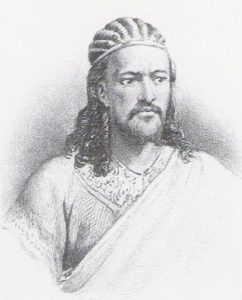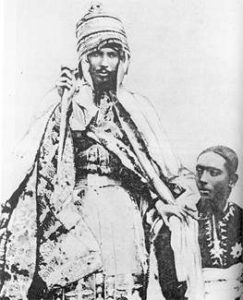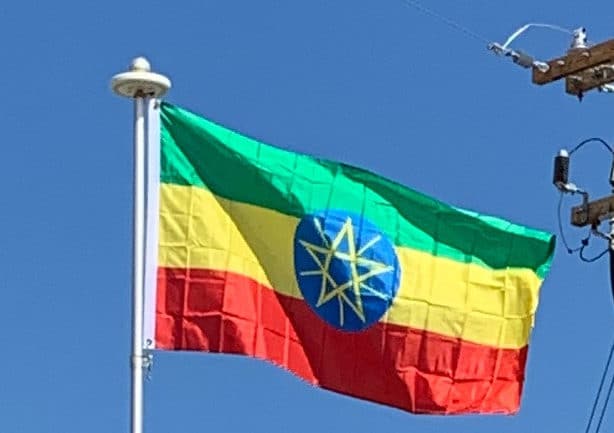Ethiopian isolationism ended following a British mission that concluded an alliance between the two nations, but it was not until 1855 that the Amhara kingdoms of northern Ethiopia (Gonder, Gojam, Shoa) were briefly united after the power of the Emperor was restored beginning with the reign of Tewodros II. Tewodros had been born in Begemder from a nobleman of Qwara, where the Qwara dialect of the Agaw language is spoken.

Upon his ascent, he began modernizing Ethiopia and recentralizing power in the Emperor. Ethiopia began to take part in world affairs once again.
But Tewodros suffered several rebellions inside his empire. Northern Oromo militias, Tigrayan rebellion, and the constant incursion of Ottoman Empire and Egyptian forces near the Red Sea brought the weakening and the final downfall of Tewodros II. He killed himself in 1868 during his last fight with the British Expedition to Abyssinia at the Battle of Magdala.
After Tewodros’ death, Tekle Giyorgis II was proclaimed Emperor but was defeated in the Battles of Zulawu (21 June 1871) and Adua (11 July 1871).
The victorious Mercha Kassai was subsequently declared Yohannes IV on 21 January 1872.

In 1875 and 1876, Turkish/Egyptian forces, accompanied by many European and American ‘advisors’, twice invaded Abyssinia but were initially defeated: once at the Battle of Gundet losing 800 men, and then in the second invasion, decisively defeated by Emperor Yohannes IV at the Battle of Gura on 7 March 1875, where the invading forces lost at least 3000 men by death or captured. From 1885 to 1889, Ethiopia joined the Mahdist War allied to Britain, Turkey, and Egypt against the Sudanese Mahdist State. In 1887 Menelik king of Shewa invaded the Emirate of Harar after his victory at the Battle of Chelenqo. On 10 March 1889, Yohannes IV was killed by the Sudanese Khalifah Abdullah’s army whilst leading his army in the Battle of Gallabat (also called Battle of Metemma).
From Menelik II to Adwa (1889–1913):
Ethiopia in roughly its current form began under the reign of Menelik II, who was Emperor from 1889 until his death in 1913. From his base in the central province of Shewa, Menelik set out to annex territories to the south, east and west, areas inhabited by the Oromo, Sidama, Gurage, Welayta, and other peoples. He did this with the help of Ras Gobana Dacche’s Shewan Oromo militia, which occupied lands that had not been held since Ahmad ibn Ibrahim al-Ghazi’s war, as well as other areas that had never been under Ethiopian sovereignty. Menelik’s campaign against Oromos outside his army was largely in retaliation for centuries of Oromo expansionism and the Zemene Mesafint, a period during which a succession of Oromo feudal rulers dominated the highlanders. Chief among these was the Yejju dynasty, which included Aligaz of Yejju and his brother Ali I of Yejju. Ali I founded the town of Debre Tabor in the Amhara Region, which became the dynasty’s capital.
